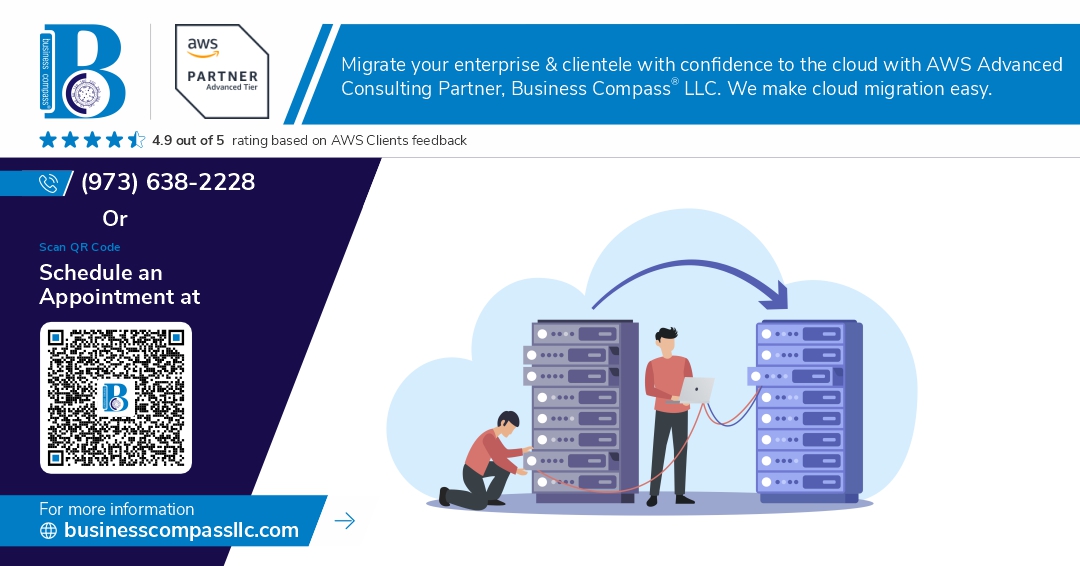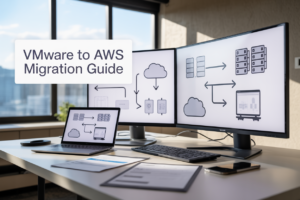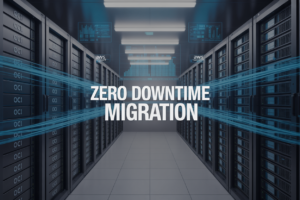Moving your data warehouse from Teradata to AWS Redshift doesn’t have to mean months of manual work and sleepless nights. Automated database migration tools can transform what used to be a complex, risky project into a streamlined process that gets you running on the cloud faster.
This guide is for data engineers, database administrators, and IT teams ready to tackle Teradata to AWS Redshift migration while keeping business operations smooth. You’ll learn practical steps that real teams use to modernize their data warehouses without the typical headaches.
We’ll walk through how to evaluate your current Teradata setup for cloud readiness and design a Redshift architecture that actually performs well for your workloads. You’ll also discover which Redshift migration automation tools work best for different scenarios and how to execute the move with minimal downtime. Finally, we’ll cover the post-migration tweaks that can save you thousands on AWS bills while keeping your queries running fast.
Assess Your Current Teradata Environment for Migration Readiness
Inventory existing data structures and dependencies
Start your Teradata migration to Redshift by mapping every table, view, stored procedure, and custom function in your current environment. Document data lineage to understand how information flows between systems and identify which tables feed into critical reports or dashboards. Create a dependency matrix showing relationships between objects, including foreign key constraints, triggers, and any custom ETL processes. This comprehensive inventory becomes your migration blueprint, ensuring no critical data structures get overlooked during the automated database migration process.
Evaluate current performance bottlenecks and limitations
Analyze query performance patterns, identifying slow-running reports and resource-intensive operations that currently strain your Teradata system. Review system logs to pinpoint peak usage times and understand workload distribution across different user groups. Document existing storage limitations, processing delays, and any workarounds your team has implemented. This performance baseline helps justify the data warehouse modernization initiative and sets clear expectations for improvement targets in your new Redshift environment.
Identify critical business processes relying on Teradata
Map out every business-critical application, report, and dashboard that connects to your Teradata warehouse. Interview stakeholders across departments to understand their daily workflows and identify any mission-critical processes that cannot tolerate extended downtime. Document SLA requirements and business impact levels for different data sources. This analysis shapes your Teradata migration best practices approach, helping prioritize which systems need immediate attention and which can migrate in later phases without disrupting operations.
Calculate total cost of ownership for current system
Break down your current Teradata expenses including licensing fees, hardware maintenance, storage costs, and staffing requirements for system administration. Factor in indirect costs like training, backup infrastructure, and disaster recovery systems. Compare these figures against projected AWS data warehouse migration costs, including Redshift pricing, data transfer fees, and migration tool expenses. This financial analysis provides compelling justification for the modernization project and helps establish realistic budgets for your cloud data warehouse migration initiative.
Design Your Target Redshift Architecture for Optimal Performance
Choose appropriate node types and cluster configurations
Selecting the right Redshift node types directly impacts your Teradata migration to Redshift success. Start with RA3 nodes for their decoupled storage and compute capabilities, allowing you to scale independently based on workload demands. For CPU-intensive analytics workloads migrating from Teradata, choose RA3.4xlarge or RA3.16xlarge nodes. Data-heavy workloads benefit from RA3.xlplus nodes with their high storage density. Size your initial cluster conservatively – you can resize without downtime. Multi-node clusters provide better performance and fault tolerance than single-node setups for production environments.
Plan data distribution strategies for improved query speed
Smart data distribution transforms your AWS data warehouse migration performance. Choose distribution keys based on your most frequent join patterns from Teradata queries. EVEN distribution works well for dimension tables under 2 million rows, while KEY distribution suits fact tables with predictable join patterns. Avoid distributing on columns with high cardinality or skewed data. Sort keys dramatically improve query performance – use compound sort keys for queries filtering on multiple columns in order, or interleaved sort keys when filter predicates vary. Analyze your Teradata query patterns before deciding on distribution strategies.
Establish security protocols and access controls
Robust security frameworks protect your modernized data warehouse during and after migration. Enable encryption at rest using AWS KMS keys and encryption in transit with SSL connections. Create IAM roles following least-privilege principles rather than sharing database credentials. Set up VPC security groups restricting access to specific IP ranges and ports. Implement database-level security with user groups, schemas, and table-level permissions mirroring your Teradata security model. Enable audit logging through CloudTrail and Redshift audit logs to track all database activities and maintain compliance requirements.
Design backup and disaster recovery procedures
Automated backup strategies ensure business continuity for your cloud data warehouse migration. Configure automated snapshots with appropriate retention periods – daily snapshots retained for 35 days provide good coverage for most organizations. Cross-region snapshot copying protects against regional failures. Manual snapshots before major changes create restore points for quick rollbacks. Design recovery procedures with clear RTO and RPO targets. Test restoration processes regularly using non-production clusters. Document step-by-step recovery procedures including network configuration, security group settings, and application connection string updates to minimize downtime during actual recovery scenarios.
Select and Configure Migration Automation Tools
Compare leading migration platforms and their capabilities
AWS Database Migration Service (DMS) stands out as the top choice for Teradata to Redshift migration, offering native AWS integration and automated schema conversion through the Schema Conversion Tool (SCT). Third-party solutions like Informatica Cloud Data Integration and Talend provide robust ETL capabilities with visual workflows, while open-source tools like Apache Airflow offer cost-effective alternatives for custom migration pipelines. Enterprise platforms such as Matillion and SnapLogic deliver pre-built connectors specifically designed for data warehouse modernization projects, reducing development time significantly.
Set up automated schema conversion utilities
The AWS Schema Conversion Tool automatically transforms Teradata DDL statements, stored procedures, and SQL functions into Redshift-compatible syntax. Configure SCT by connecting to your source Teradata environment and target Redshift cluster, then run assessment reports to identify conversion complexity. Set up conversion rules for data type mapping, distribution keys, and sort keys based on your target architecture requirements. Schedule regular schema synchronization jobs to capture any structural changes in your source system during the migration window.
Configure data validation and quality checks
Implement row count validation, checksum verification, and data sampling techniques to ensure migration accuracy across all tables. Set up automated data profiling jobs that compare source and target datasets, flagging discrepancies in null values, data distributions, and referential integrity constraints. Configure delta validation processes that continuously monitor data consistency during incremental loads. Deploy data quality frameworks like Great Expectations or custom Python scripts to validate business rules and data format requirements post-migration.
Establish monitoring and logging mechanisms
Deploy comprehensive logging across all migration components using AWS CloudWatch for real-time performance monitoring and error tracking. Set up custom dashboards that display migration progress, throughput metrics, and error rates for each table or schema being transferred. Configure automated alerting systems that notify teams of failed jobs, performance bottlenecks, or data validation failures. Implement audit trails that capture detailed migration metadata, including timestamps, data volumes, and transformation applied during the Redshift migration automation process.
Execute Automated Data Transfer with Minimal Downtime
Implement incremental data migration strategies
Start with a phased approach that moves data in manageable chunks rather than attempting a massive one-time transfer. Set up CDC (Change Data Capture) to track ongoing changes in your Teradata system while migration runs in the background. This Teradata migration to Redshift strategy keeps your source system operational while systematically moving historical data first, followed by recent changes. Use timestamp-based partitioning to create logical data segments that can be migrated independently. Configure automated scripts to handle table dependencies and maintain referential integrity across migration waves. Schedule transfers during low-usage periods to minimize impact on business operations.
Run parallel processing for large dataset transfers
Leverage AWS DMS (Database Migration Service) or third-party tools that support multi-threaded processing for your automated database migration. Split large tables across multiple worker threads based on primary keys or hash values to maximize throughput. Configure your network bandwidth and Redshift cluster to handle concurrent data streams without bottlenecks. Use compression algorithms during transit to reduce network load and speed up transfers. Monitor resource utilization on both source and target systems to optimize parallel thread counts. Set up automated retry mechanisms for failed batches to ensure complete data transfer without manual intervention.
Validate data integrity throughout the migration process
Build comprehensive validation checkpoints at every migration stage using automated row counts, checksums, and statistical comparisons between source and target datasets. Create custom validation scripts that verify data types, null values, and constraint compliance in your AWS data warehouse migration. Implement real-time monitoring dashboards that alert teams to discrepancies immediately. Use sampling techniques to perform deep data quality checks on representative subsets of migrated data. Set up automated rollback procedures for corrupted transfers. Document all validation results to create an audit trail for compliance requirements and troubleshooting purposes.
Optimize Post-Migration Performance and Cost Efficiency
Fine-tune query performance using Redshift best practices
Query optimization becomes critical after your Teradata migration to Redshift succeeds. Start by analyzing slow-running queries using Redshift’s built-in performance insights and query monitoring tools. Choose appropriate distribution keys based on your most frequent join patterns, and select sort keys that align with your filtering and grouping operations. Compress data using automatic compression encoding, and regularly run the VACUUM and ANALYZE commands to maintain optimal performance. Consider materializing frequently accessed views and partitioning large tables by date ranges to reduce scan times.
Implement automated scaling based on workload demands
Redshift’s elastic resize and concurrency scaling features handle varying workload demands without manual intervention. Configure automatic scaling policies that monitor queue wait times and cluster utilization metrics. Set up CloudWatch alarms to trigger scaling events when query queues exceed predefined thresholds or when CPU utilization remains high for extended periods. Use scheduled scaling for predictable workload patterns, scaling up during business hours and down during off-peak times. This automated approach ensures your AWS data warehouse migration delivers consistent performance while controlling costs.
Set up cost monitoring and resource optimization alerts
Cost control requires proactive monitoring of your Redshift cluster usage patterns. Deploy AWS Cost Explorer and CloudWatch dashboards to track hourly spending and identify cost spikes. Create budget alerts that notify administrators when monthly costs exceed predetermined limits. Monitor reserved instance utilization to maximize savings opportunities, and track query costs using Redshift’s system tables. Set up alerts for idle clusters, unused tables, and inefficient queries that consume excessive resources. Regular cost reviews help identify optimization opportunities and prevent unexpected charges in your cloud data warehouse migration.
Establish ongoing maintenance and update procedures
Regular maintenance keeps your Redshift environment running smoothly after database modernization. Schedule automated backups and test restore procedures monthly to ensure data recovery capabilities. Plan quarterly reviews of table designs, distribution keys, and sort keys as your data patterns evolve. Update cluster versions during planned maintenance windows to access new features and security patches. Document operational procedures for common tasks like adding users, managing permissions, and troubleshooting performance issues. Create runbooks for incident response and establish monitoring protocols that alert teams to potential problems before they impact users.
Moving from Teradata to Redshift doesn’t have to be a nightmare when you take the right approach. The key steps we’ve covered – from assessing your current setup to optimizing your new environment – form a roadmap that can save you months of headaches and costly mistakes. Getting your Teradata environment migration-ready and designing a solid Redshift architecture upfront will pay dividends throughout the entire process.
The real game-changer is choosing the right automation tools and executing your migration strategically to keep downtime to a minimum. Once you’re live on Redshift, the work isn’t done – ongoing performance tuning and cost optimization will ensure you’re getting the most bang for your buck. Start by auditing your current Teradata setup today, and begin planning your migration journey. Your future self will thank you for taking the time to do this right the first time.




















